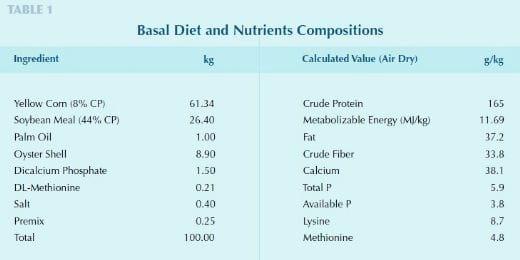Mycotoxin Binder in Layers
Mycotoxin Binder Passes Safety Tests in Layers
Published: April 25, 2011
By: Chaiyapoom Bunchasak, Chanwit Keawtapee, Fang Chi and Jonathan Broomhead (Amlan International)
Introduction
Laying hens are highly sensitive to aflatoxin toxicity. When fed aflatoxin contaminated feed there may be reduced egg production, egg weight, serum protein, serum albumin, and an increase in target organ weight, such as the liver and kidneys. In Southeast Asia where Aflatoxin is commonly found, producers regularly use mycotoxin binders in animal feed to prevent aflatoxicosis. Many producers believe that mineral-based mycotoxin binders will non-selectively bind vitamins and other nutrients along with the mycotoxins in the diet, thereby reducing animal performance. The objective of this current study is to evaluate the effects of Calibrin-A enterosorbent on egg production, egg weight, and egg quality. It is proposed that feeding Calibrin-A enterosorbent for lengthy periods does not influence nutrients, metabolism or normal growth in layers.
Experimental Procedures
Experimental Procedures
A total of 480 laying hens (Hisex Brown, ISA) from 30 to 46 weeks of age with an average weight of 1.90 kg were used to determine the effect of Calibrin-A enterosorbent on production performance and egg quality. The hens were randomly assigned to 4 treatments with 10 replicate pens of 12 hens each. The same basal diet (Table 1) was used in the study. All diets were formulated to Isocaloric and isonutrient except Calibrin-A enterosorbent inclusions with 0, 0.05, 0.1, or 0.2%, separately, in the four treatment diets. Hens were fed the treatment diets ad libitum for 16 weeks.
Calibrin-A enterosorbent was provided by Thai Vet Nutri Tech Co. Ltd (Chonburi, Thailand) and a commercial feed mill produced the feed. The trial was conducted at the university research farm from January to May 2009 (Bangkok, Thailand). Feed samples were sent to Asia Mycotoxins Analysis Center at Chaoyang University Technology (Taichung, Taiwan) using ELISA kits (VICAM) to determine the mycotoxin content. No aflatoxin, DON, and zearalenone were detectable; however, fumonisin concentrations ranged from 0.63 to 5.0 ppm in the feed.


Results and Discussion
Hen body weights after 16 weeks feeding were similar (P = 0.43) between treatments and slightly less than its initial weigh ts in all treatments with 81, 41, 65, and 48 grams differences, respectively, for 0, 0.05, 0.1, and 0.2% Calibrin-A inclusion (Table 2).
Daily feed intake was not different between treatments with an average of 118.5 grams. Egg production and egg weight did not vary between treatments (P > 0.05), and therefore, the calculated total egg mass and feed conversion showed no differences between treatments either.
These results show that under normal feeding practices and without additional stress challenges, feeding Calibrin-A enterosorbent for 16 weeks did not influence layer body weight, feed intake, egg production or egg size. We can conclude that no interference of dietary energy, nutrients, vitamins, and minerals utilization of feeding Calibrin-A enterosorbent.
Treatment effects of feeding different levels of Calibrin-A enterosorbent on egg quality are shown in the Table 3. Albumen height and weight, yolk weight, and their ratios to egg weight were not different between treatments (P > 0.05). Yolk color using BASF 1-15 scoring system showed no difference between treatments. However, hens fed diets containing 0.05% Calibrin-A had greater shell thickness (P <0.05) and Amlan International web: www.amlan.com email: info@amlan.com phone: 312.321.1887 fax: 312.321.9525 better Haugh units (P< 0.10) than hens fed the control diet. There were no differences between hens fed the control diet and hens fed 0.1 or 0.2% Calibrin-A diets. It is unclear why the different inclusion rates of Calibrin-A resulted in a significant difference in shell thickness.
Results also showed that the overall egg quality was not influenced by feeding Calibrin-A. This suggests that feeding Calibrin-A to layers for a lengthy period was safe and did not have any negative impacts on performance and egg quality.
In southern China, a year long side -by-side comparison had shown that laying hens receiving clay enterosorbents had better performance than a control group (unpublished data), suggesting that clay enterosorbents may reduce feed variation from batch to batch. However in the current study, we did not observe improved performance in layer or egg quality over 16 weeks feeding in the study, except an improvement of shell thickness of feeding 0.05% Calibrin-A enterosorbent. It may be due to the absence of additional challenges, such as mycotoxins and heat stress etc. in the current study. In fact, mortality was low in the study, with 4 hens (out of 480 hens) dead over 16 weeks (1 hen in treatment 1, 2 hens in treatment 2, and 1 hen in treatment 3), implying good health of layer and low environmental stress during the feeding period.
Although fumonisin was detected in test diets, the levels were not high enough to influence normal performance in chicken. Nevertheless, hens fed diets containing 0.05% Calibrin-A enterosorbent numerically maintained body weight better (41 g vs. 81 g loss), had lower coefficient of variance for egg production (3.76% vs. 3.93%), had greater Haugh unit (84.1 vs. 82.8), and significantly improved shell thickness (0.375 mm vs 0.370 mm) than hens fed the control diet. This implies some positive effects of feeding 0.05% Calibrin-A in the layer feed under normal feeding practice.
In conclusion, no differences were found between treatments on egg production, egg weight and egg quality indicating that feeding Calibrin-A for a long time was safe and the Calibrin-A enterosorbent had no interference with dietary nutrients utilization in layer.
Related topics
Authors:
Amlan
Perstorp Feed & Food
Recommend
Comment
Share

Would you like to discuss another topic? Create a new post to engage with experts in the community.










.jpg&w=3840&q=75)